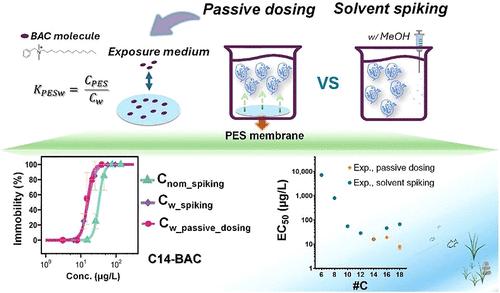当前位置:
X-MOL 学术
›
Environ. Sci. Technol.
›
论文详情
Our official English website, www.x-mol.net, welcomes your feedback! (Note: you will need to create a separate account there.)
Developing a Passive Dosing Method for Acute Aquatic Toxicity Tests of Cationic Surfactant Benzalkoniums (BACs)
Environmental Science & Technology ( IF 10.8 ) Pub Date : 2024-07-24 , DOI: 10.1021/acs.est.4c03027 Anh T. Ngoc Do 1 , Kyoshiro Hiki 1 , Haruna Watanabe 1 , Hiroshi Yamamoto 1 , Satoshi Endo 1
Environmental Science & Technology ( IF 10.8 ) Pub Date : 2024-07-24 , DOI: 10.1021/acs.est.4c03027 Anh T. Ngoc Do 1 , Kyoshiro Hiki 1 , Haruna Watanabe 1 , Hiroshi Yamamoto 1 , Satoshi Endo 1
Affiliation

|
Benzalkonium chlorides (BACs) have been of environmental concern due to their widespread use and potential harm. However, challenges arise in defining and controlling the exposure concentration (Cw) in aquatic toxicity tests involving BACs with a long alkyl chain (i.e., #C > 14). To address this, a novel passive dosing method was introduced in the 48 h-acute ecotoxicity test on Daphnia magna and compared to the conventional solvent-spiking method in terms of Cw stability and toxicity results. Among 13 sorbent materials tested for their sorption capacity, poly(ether sulfone) (PES) membrane was an optimal passive dosing reservoir, with equilibrium desorption of BACs to water achieved within 24 h. The Cw of BACs remained constant in both applied dosing methods during the test period. However, the Cw in solvent-spiking tests was lower than the nominal concentration for long-chain BACs, particularly at low exposure concentrations. Notably, the solvent-spiking tests indicated that the toxicity of BACs increased with alkyl chain length from C6 to 14, followed by a decline in toxicity from C14 to 18. In contrast, the passive dosing method displayed similar or slightly increasing toxicity levels of BACs from C14 to C18, indicating higher toxicity of C16 and C18-BACs than that inferred by the solvent spiking test. These findings emphasize the potential of applying this innovative passive dosing approach in aquatic toxicity tests to generate reliable and accurate toxicity data and support a comprehensive risk assessment of cationic surfactants.
中文翻译:

开发用于阳离子表面活性剂苯扎氯铵 (BAC) 急性水生毒性测试的被动给药方法
苯扎氯铵 (BAC) 由于其广泛使用和潜在危害而引起环境问题。然而,在涉及长烷基链(即 #C > 14)的 BAC 的水生毒性测试中,在定义和控制暴露浓度 (C w ) 方面存在挑战。为了解决这个问题,我们在大型溞的48小时急性生态毒性试验中引入了一种新型被动加药方法,并与传统的溶剂加标方法的C w 稳定性和毒性结果进行了比较。在测试吸附能力的 13 种吸附剂材料中,聚醚砜 (PES) 膜是最佳的被动剂量储存器,在 24 小时内实现了 BAC 向水中的平衡解吸。在测试期间,两种应用的给药方法中 BAC 的 C w 保持恒定。然而,溶剂加标测试中的 C w 低于长链 BAC 的标称浓度,特别是在低暴露浓度下。值得注意的是,溶剂加标测试表明,BAC 的毒性随着烷基链长度从 C6 增加到 14 而增加,随后毒性从 C14 到 18 下降。相比之下,被动给药方法显示 BAC 的毒性水平相似或略有增加从 C14 到 C18,表明 C16 和 C18-BAC 的毒性比溶剂加标测试推断的毒性更高。这些发现强调了在水生毒性测试中应用这种创新的被动给药方法的潜力,以生成可靠和准确的毒性数据并支持阳离子表面活性剂的全面风险评估。
更新日期:2024-07-25
中文翻译:

开发用于阳离子表面活性剂苯扎氯铵 (BAC) 急性水生毒性测试的被动给药方法
苯扎氯铵 (BAC) 由于其广泛使用和潜在危害而引起环境问题。然而,在涉及长烷基链(即 #C > 14)的 BAC 的水生毒性测试中,在定义和控制暴露浓度 (C w ) 方面存在挑战。为了解决这个问题,我们在大型溞的48小时急性生态毒性试验中引入了一种新型被动加药方法,并与传统的溶剂加标方法的C w 稳定性和毒性结果进行了比较。在测试吸附能力的 13 种吸附剂材料中,聚醚砜 (PES) 膜是最佳的被动剂量储存器,在 24 小时内实现了 BAC 向水中的平衡解吸。在测试期间,两种应用的给药方法中 BAC 的 C w 保持恒定。然而,溶剂加标测试中的 C w 低于长链 BAC 的标称浓度,特别是在低暴露浓度下。值得注意的是,溶剂加标测试表明,BAC 的毒性随着烷基链长度从 C6 增加到 14 而增加,随后毒性从 C14 到 18 下降。相比之下,被动给药方法显示 BAC 的毒性水平相似或略有增加从 C14 到 C18,表明 C16 和 C18-BAC 的毒性比溶剂加标测试推断的毒性更高。这些发现强调了在水生毒性测试中应用这种创新的被动给药方法的潜力,以生成可靠和准确的毒性数据并支持阳离子表面活性剂的全面风险评估。












































 京公网安备 11010802027423号
京公网安备 11010802027423号